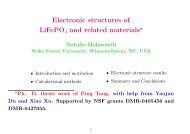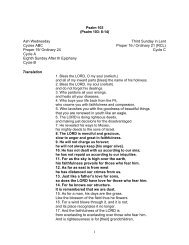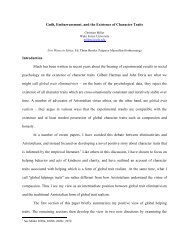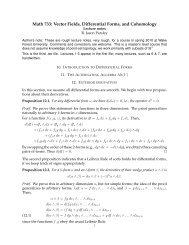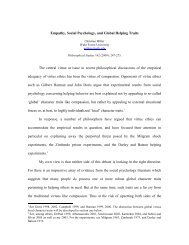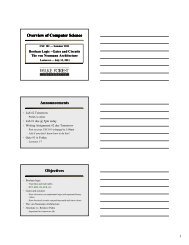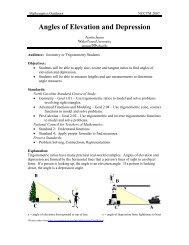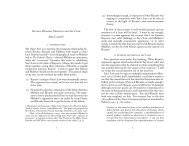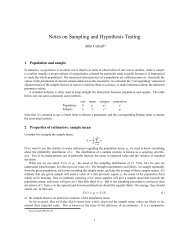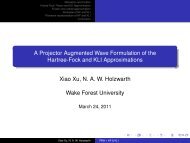5.4 Environmetrics and ChemometricsIn the air pollution research community, one observational technique makes use of the ambientdata and source profile data to apportion sources or source categories [39, 44, 75]. Thefundamental pr<strong>in</strong>ciple <strong>in</strong> this model is that mass conservation can be assumed and a massbalance analysis can be used to identify and apportion sources of airborne particulate matter<strong>in</strong> the atmosphere. For example, it might be desirable to determ<strong>in</strong>e a large number of chemicalconstituents such as elemental concentrations <strong>in</strong> a number of samples. The relationshipsbetween p sources which contribute m chemical species to n samples leads to a mass balanceequationp∑y ij = a ik f kj , (36)k=1where y ij is the elemental concentration of the ith chemical measured <strong>in</strong> the j th sample,a ik is the gravimetric concentration of the ith chemical <strong>in</strong> the kth source, and f kj is theairborne mass concentration that the kth source has contributed to the j th sample. In atypical scenario, only values of y ij are observable whereas neither the sources are known northe compositions of the local particulate emissions are measured. Thus, a critical questionis to estimate the number p, the compositions a ik , and the contributions f kj of the sources.Tools that have been employed to analyze the l<strong>in</strong>ear model <strong>in</strong>clude pr<strong>in</strong>cipal componentanalysis, factor analysis, cluster analysis, and other multivariate statistical techniques. Inthis receptor model, however, there is a physical constra<strong>in</strong>t imposed upon the data. That is,the source compositions a ik and the source contributions f kj must all be nonnegative. Theidentification and apportionment problems thus become a nonnegative matrix factorizationproblem for the matrix Y.5.5 Speech RecognitionStochastic language model<strong>in</strong>g plays a central role <strong>in</strong> large vocabulary speech recognition,where it is usually implemented us<strong>in</strong>g the n-gram paradigm. In a typical application, thepurpose of an n-gram language model may be to constra<strong>in</strong> the acoustic analysis, guide thesearch through various (partial) text hypotheses, and/or contribute to the determ<strong>in</strong>ation ofthe f<strong>in</strong>al transcription.In language model<strong>in</strong>g one has to model the probability of occurrence of a predicted wordgiven its history P r(w n |H). N-gram based Language Models have been used successfully <strong>in</strong>Large Vocabulary Automatic Speech Recognition Systems. In this model, the word historyconsists of the N − 1 immediately preced<strong>in</strong>g words. Particularly, tri-gram language models(P r(w n |w n−1 ; w n−2 )) offer a good compromise between model<strong>in</strong>g power and complexity. Amajor weakness of these models is the <strong>in</strong>ability to model word dependencies beyond the spanof the n-grams. As such, n-gram models have limited semantic model<strong>in</strong>g ability. Alternatemodels have been proposed with the aim of <strong>in</strong>corporat<strong>in</strong>g long term dependencies <strong>in</strong>to themodel<strong>in</strong>g process. Methods such as word trigger models, high-order n-grams, cache models,etc., have been used <strong>in</strong> comb<strong>in</strong>ation with standard n-gram models.One such method, a Latent Semantic <strong>Analysis</strong> based model has been proposed [2]. Aword-document occurrence matrix X m×n is formed (m = size of the vocabulary, n = number22
of documents), us<strong>in</strong>g a tra<strong>in</strong><strong>in</strong>g corpus explicitly segmented <strong>in</strong>to a collection of documents.A S<strong>in</strong>gular Value Decomposition X = USV T is performed to obta<strong>in</strong> a low dimensional l<strong>in</strong>earspace S, which is more convenient to perform tasks such as word and document cluster<strong>in</strong>g,us<strong>in</strong>g an appropriate metric. Bellegarda [2] gave the detail<strong>in</strong>g explanation about this method.In the paper [63], Novak and Mammone <strong>in</strong>troduce a new method with NMF. In additionto the non-negativity, another property of this factorization is that the columns of W tend torepresent groups of associated words. This property suggests that the columns of W can be<strong>in</strong>terpreted as conditional word probability distributions, s<strong>in</strong>ce they satisfy the conditionsof a probability distribution by the def<strong>in</strong>ition. Thus the matrix W describes a hiddendocument space D = {d j } by provid<strong>in</strong>g conditional distributions W = P(w i |d j ). The taskis to f<strong>in</strong>d a matrix W, given the word document count matrix X. The second term of thefactorization, matrix H, reflects the properties of the explicit segmentation of the tra<strong>in</strong><strong>in</strong>gcorpus <strong>in</strong>to <strong>in</strong>dividual documents. This <strong>in</strong>formation is not of <strong>in</strong>terest <strong>in</strong> the context ofLanguage Model<strong>in</strong>g. They provide an experimental result where the NMF method results<strong>in</strong> a perplexity reduction of 16% on a database of biology lecture transcriptions.5.6 Spectral Unmix<strong>in</strong>g by NMF and NTFHere we discuss applications of NMF and NTF to numerical methods for the classification ofremotely sensed objects. We consider the identification of space satellites from non-imag<strong>in</strong>gdata such as spectra of visible and NIR range, with different spectral resolutions and <strong>in</strong> thepresence of noise and atmospheric turbulence (See, e.g., [68] or [69, 70].). This is the researcharea of space object identification (SOI).A primary goal of us<strong>in</strong>g remote sens<strong>in</strong>g image data is to identify materials present <strong>in</strong>the object or scene be<strong>in</strong>g imaged and quantify their abundance estimation, i.e., to determ<strong>in</strong>econcentrations of different signature spectra present <strong>in</strong> pixels. Also, due to the large quantityof data usually encountered <strong>in</strong> hyperspectral datasets, compress<strong>in</strong>g the data is becom<strong>in</strong>g<strong>in</strong>creas<strong>in</strong>gly important. In this section we discuss the use of MNF and NTF to reach thesemajor goals: material identification, material abundance estimation, and data compression.For safety and other considerations <strong>in</strong> space, non-resolved space object characterization isan important component of Space Situational Awareness. The key problem <strong>in</strong> non-resolvedspace object characterization is to use spectral reflectance data to ga<strong>in</strong> knowledge regard<strong>in</strong>gthe physical properties (e.g., function, size, type, status change) of space objects that cannotbe spatially resolved with telescope technology. Such objects may <strong>in</strong>clude geosynchronoussatellites, rocket bodies, platforms, space debris, or nano-satellites. Figure 3 shows an artist’srendition of a JSAT type satellite <strong>in</strong> a 36,000 kilometer high synchronous orbit around theEarth. Even with adaptive optics capabilities, this object is generally not resolvable us<strong>in</strong>gground-based telescope technology.Spectral reflectance data of a space object can be gathered us<strong>in</strong>g ground-based spectrometersand conta<strong>in</strong>s essential <strong>in</strong>formation regard<strong>in</strong>g the make up or types of materialscompris<strong>in</strong>g the object. Different materials such as alum<strong>in</strong>um, mylar, pa<strong>in</strong>t, etc. possesscharacteristic wavelength-dependent absorption features, or spectral signatures, that mixtogether <strong>in</strong> the spectral reflectance measurement of an object. Figure 4 shows spectral signaturesof four materials typically used <strong>in</strong> satellites, namely, alum<strong>in</strong>um, mylar, white pa<strong>in</strong>t,and solar cell.23



